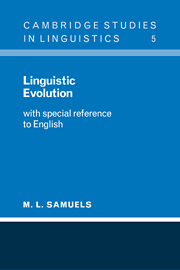Book contents
- Frontmatter
- Contents
- Preface
- Note to second impression
- Abbreviations
- 1 Introduction
- 2 Variation in the spoken chain
- 3 System: the phoneme
- 4 Grammar and lexis (I): variation
- 5 Grammar and lexis (II): systemic regulation
- 6 Diversity and contact
- 7 An assessment of the problem
- 8 Dimensions of study
- 9 Conclusions
- Bibliography
- Index of persons
- Index of subjects
- Plate section
5 - Grammar and lexis (II): systemic regulation
Published online by Cambridge University Press: 05 June 2012
- Frontmatter
- Contents
- Preface
- Note to second impression
- Abbreviations
- 1 Introduction
- 2 Variation in the spoken chain
- 3 System: the phoneme
- 4 Grammar and lexis (I): variation
- 5 Grammar and lexis (II): systemic regulation
- 6 Diversity and contact
- 7 An assessment of the problem
- 8 Dimensions of study
- 9 Conclusions
- Bibliography
- Index of persons
- Index of subjects
- Plate section
Summary
Introductory
It is evident that if the multiplication of new meanings for a single form, or of new forms for a single meaning (i.e. initially ‘pure synonyms’) were to continue on the lines set out in the preceding chapter, without any counter-balancing or regulating mechanism, the language would break down as a system of communication. But that would occur only if there were an abnormal preponderance of ‘form-directed’ utterance (cf. 3.1) in which speakers were taking only the immediate context into account. The counterbalance is ‘function-directed’ utterance, in which the speaker consciously or subconsciously considers more than immediate context, i.e. the overall system or those parts of it that are relevant to the utterance. Every individual, whether his utterance be commonplace or unusual, careless or creative, must, if he wishes to avoid ambiguity and remain intelligible, allow for the system to which his utterance belongs; and to that extent his utterance can be regarded as collective as well as individual in significance.
Avoidance of ambiguity means that of all the alternative forms available to a speaker, whether in grammatical paradigm or lexical set, he selects only those that are clearest and least likely to give rise to ambiguity, i.e. in each of the many acts of selection necessary for the utterance, he must prefer some forms and reject others. Now, just as all the extensions discussed above are spread by imitation, so the avoidance of features may also be spread; not everyone exercises the same degree of care in selection, or avoids the same features, but the collective effect is a regulating mechanism which takes the form of processes that will counteract extension: limitation, and differentiation.
- Type
- Chapter
- Information
- Linguistic EvolutionWith Special Reference to English, pp. 64 - 87Publisher: Cambridge University PressPrint publication year: 1972



